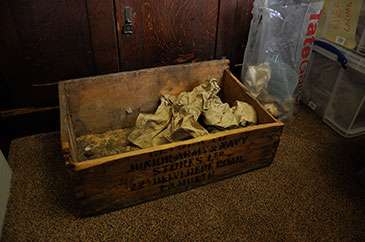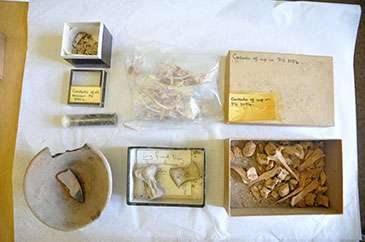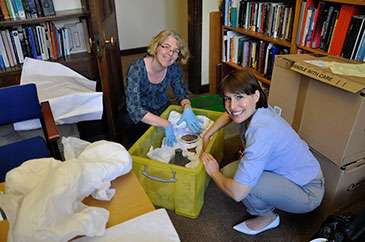Hidden treasures of ancient Ur uncovered in Bristol

(Phys.org) —An enigmatic box from a bygone era, filled with pottery, seeds and animal bones, has been discovered in the University of Bristol's Department of Archaeology and Anthropology. The box was found while researchers were emptying current laboratory spaces in preparation for the installation of a new state-of-the-art radiocarbon dating facility.
Index cards nestled amongst the objects in the box provided a clue to the origins of the material. Key words such as 'Predynastic', 'Sargonid', and 'Royal Tombs' suggested the remains came from the famous excavations by Sir Leonard Woolley in southern Iraq at the site of Ur during the 1920s and early 1930s.
The discovery is very exciting because environmental finds were rarely collected in this early period of archaeological fieldwork, especially from this part of the world.
Further investigation revealed that these were the remains of food offerings from a royal tomb at least 4,500 years old.
The original excavation was sponsored jointly by the British Museum and the University of Pennsylvania Museum, and the finds were divided between London, Philadelphia and Baghdad, following the tradition of the era.
Therefore, Dr Tamar Hodos, Senior Lecturer in Archaeology at Bristol, contacted Dr Alexandra Fletcher, Raymond and Beverly Sackler Curator of Near Eastern Archaeology at the British Museum, about where the material should be housed.

The British Museum immediately offered the remains a new home, where they will join the rest of the museum's collection from Ur – holdings which are currently both on display (rooms 55-56) and part of a major digitisation programme sponsored by the Leon Levy Foundation and undertaken with the University of Pennsylvania Museum.
Dr Hodos said: "The remaining mystery is how this material came to be at Bristol in the first place. The environmental remains themselves were published in 1978 in Journal of Archaeological Science. The authors of that study were based at the Institute of Archaeology, London, and at the University of Southampton, and none of them had any known connection to the University of Bristol that might explain how the material came to reside here. If anyone can shed light on this mystery, we would love to hear from them."

The University of Bristol's new radiocarbon dating facility, due to open in the autumn of 2015, will allow Bristol to offer a world-beating service for the dating of ancient artefacts and ecofacts (organic material found at archaeological sites).
If you can shed some light on how the box came to Bristol, please contact Dr Tamar Hodos (t.hodos@bristol.ac.uk) or Dr Alexandra Fletcher (afletcher@britishmuseum.org).
Journal information: Journal of Archaeological Science
Provided by University of Bristol



















